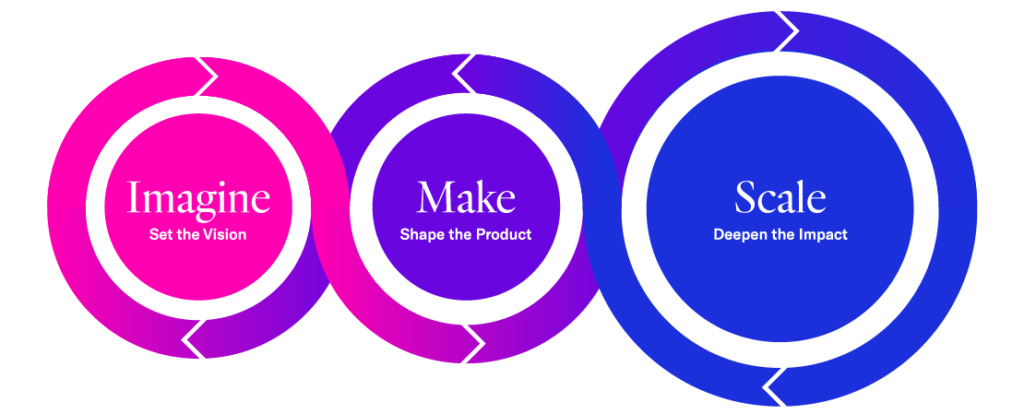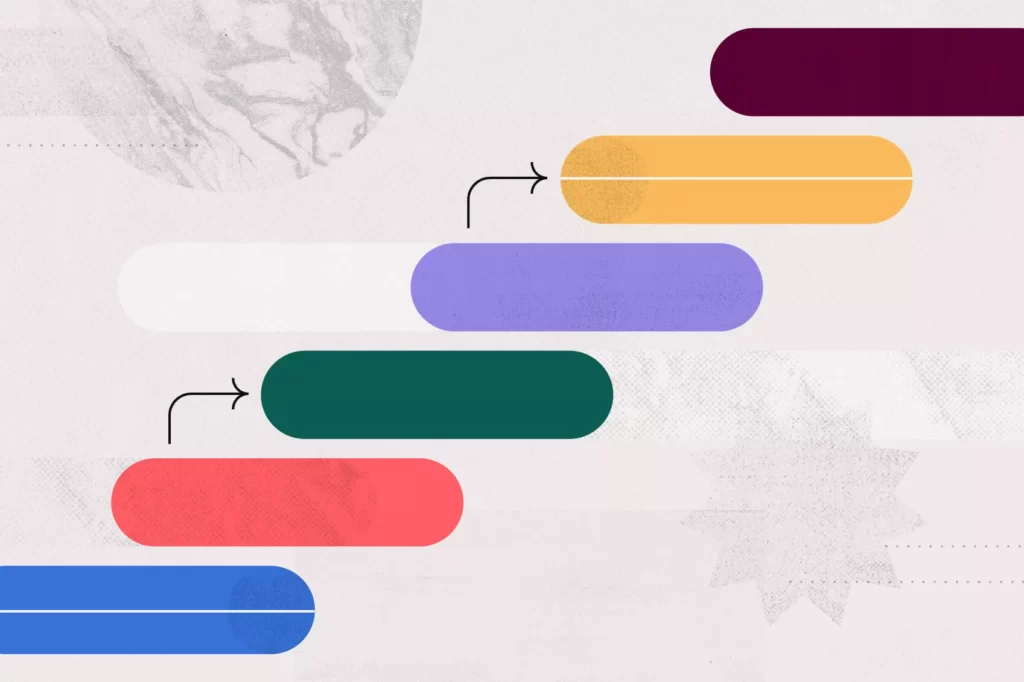DesignOps: How to Foster Collaboration Between Designers and Developers
The relationship between designers and developers is critical to the success of any product, yet they can often find themselves working at cross-purposes. DesignOps is a methodology designed to foster collaboration between the two, with the ultimate goal of creating an integrated system that enables teams to move quickly and efficiently.
In this blog post, we'll explore the fundamentals of DesignOps and how it can help bridge the gap between designers and developers.
Table of Contents
What is DesignOps?

DesignOps, or Design Operations, is a term that describes the practices, tools, and processes that enable designers and developers to collaborate and improve the design process. DesignOps focuses on improving the efficiency and quality of product design, increasing productivity, and scaling design teams and operations. DesignOps professionals are responsible for streamlining design workflows and establishing an effective design culture in organisations.
DesignOps teams can include product designers, UX designers, UI designers, product managers, design thinkers, and others who work together to create successful products. DesignOps professionals strive to improve the design process by identifying opportunities to optimise design operations and develop more effective design tools. They may also explore ways to better communicate with stakeholders, such as product managers, engineers, and executives.
DesignOps roles often involve working with technical and non-technical teams, so professionals in this field must have technical and design skills. They must be able to develop strategies for improving design operations, helping teams scale, and creating a better overall design practice.
DesignOps is an integral part of DevOps culture and becoming an increasingly sought-after career path for many designers. It offers a unique opportunity to impact product development and improve how design teams work together. By helping to create an efficient and effective design culture, DesignOps professionals can help companies build better products faster.
The Benefits of DesignOps

DesignOps can benefit design teams, product development, and product design. DesignOps is an increasingly popular approach to streamlining the design process and scaling design operations. It encourages collaboration between designers, product managers, and other stakeholders, leading to improved design outcomes and a more efficient design workflow.
Design Team Collaboration
DesignOps provides a framework for uniting a design team and fostering collaboration. It allows different areas of the design process to be connected, creating a clear vision of the product that everyone involved can work towards. This also helps with communication and accountability, as every team member knows their role in the overall process.
Design Culture
DesignOps encourages a culture of experimentation and innovation within the design team. By connecting different parts of the design process and allowing for cross-collaboration, teams can discover new approaches and create better products faster. DesignOps also helps create a career path for designers, allowing them to explore their skills and interests within the organisation.
Improve Design Quality
DesignOps can help improve the quality of product designs by providing better tools for product development. With better design tools and resources, teams can quickly develop prototypes and iterate on designs to create a better user experience. DesignOps also provides a platform for sharing best practices and learning from each other's experiences.
Design Thinking
DesignOps also encourages designers to think outside of the box when creating products. By bringing together different disciplines, such as UI/UX design, product management, and engineering, teams can explore creative solutions to product design challenges. This encourages a mindset of “design thinking” that can result in innovative products.
Scale Design
DesignOps helps companies scale their design operations without compromising on quality. By providing teams with the right tools and resources, companies can quickly expand their design teams and take on more complex projects. DesignOps also makes it easier for teams to manage multiple projects at once, allowing them to move quickly and deliver better results.
Design operations are gaining more ground because it helps organisations to align design with business goals and to optimise design processes. This can result in better design outcomes and increased efficiency. Additionally, as design becomes increasingly important to organisations, there is a growing recognition that it needs to be managed and scaled in a structured way, similar to how other business functions are managed. This has led to the emergence of design operations as a distinct field.
The Challenges of DesignOps
DesignOps is a relatively new field, and as such, it presents its unique challenges. One of the biggest challenges is creating a cohesive design team. Design teams have different roles, including product design, UX design, UI design, and product management. With proper organisation and communication, the collaboration between these roles can be more manageable.
DesignOps also requires the implementation of effective design processes and systems. A successful DesignOps team should be able to scale the design process to meet the needs of a growing product. This can be challenging, as many design tools and methods must be managed to ensure smooth product development.
Creating a career path for DesignOps team members can be difficult as well. DesignOps is still a relatively new field, with few established career paths. This can make it difficult for designers and developers to gain experience in the area and improve their skills.
Finally, there is the challenge of fostering collaboration between design teams and the other departments within a company. DesignOps teams must work closely with product managers and engineers to ensure that the product meets its goals. Designers must also have a strong understanding of design thinking and be able to communicate their ideas effectively. With proper collaboration between these departments, product development can thrive.
How to Foster Collaboration Between Designers and Developers

Collaboration between designers and developers is essential for successful product design, development, and delivery. DesignOps provides the structure and processes to ensure that both parties have a cohesive and effective workflow. Here are some tips on how to foster collaboration between designers and developers:
1 – Design Team Structure
The first step in fostering collaboration is creating a design team structure. This should include roles such as product design, UX design, UI design, and design operations. Each part should have clear goals, objectives, and responsibilities. This will help improve communication and ensure everyone has the skills to collaborate effectively.
2 – Design Process
A straightforward design process will help streamline the collaboration between designers and developers. The process should cover product design, design systems, workflow, product development, and design ops. This will ensure that everyone understands what is expected of them during the design process.
3 – Design Tools
Design tools are essential for fostering collaboration between designers and developers. They can help improve design quality, scale design, create consistency, and facilitate team communication. Product managers should select tools that support their team's design practice.
4 – Design Thinking
Design thinking encourages collaboration by focusing on user needs and expectations. It involves understanding the user's context, behaviour, and motivation. This helps the design team create products that are meaningful and easy to use.
5 – Design Culture
Developing a culture of collaboration is essential for successful projects. Designers and developers should understand each other's roles and be open to feedback from both sides. They should also have a shared vision of what they want to achieve with their product.
6 – Career Paths
Career paths are essential for motivating designers and developers to work together. They should have clear goals to work towards and understand the importance of collaboration in achieving success. They should also be encouraged to take on new challenges and build on existing skill sets.
These are just a few tips for fostering collaboration between designers and developers. By understanding each other's roles, having a straightforward design process, using the right tools, and developing a culture of collaboration, teams can work together effectively to create meaningful products.
Why use DesignOps with DevOps?

DesignOps is a relatively new term, but it's quickly gaining traction in the developing world as an important way to bring the best of design and DevOps practices into one powerful team. DesignOps combines the design process, design teams, and design operations with the product development process of DevOps.
The most crucial aspect of DesignOps has a dedicated design team. This team should be composed of designers, product managers, developers, and ops specialists who can work together to create effective design processes and solutions. It should empower this team to shape the design culture within the organisation, encouraging collaboration between different disciplines and creating career paths for talented designers.
A solid design process is essential to ensure the successful implementation of DesignOps. The process should include elements of product design, user experience (UX) design, visual design, and product development. The process should also include design thinking principles and design systems to ensure that solutions are scalable, efficient, and effective.
In addition to having a well-defined process, DesignOps teams must have well-defined roles and responsibilities. Each team should be composed of individuals from various disciplines, including product managers, UX designers, UI designers, visual designers, developers, and ops specialists. Each team member needs to understand their role and how their contribution can help improve the overall design process.
Design operations involve managing the design process, workflow, and tools used by the team. This includes everything from creating a strategy for collaboration between team members to selecting the right tools and resources for the job. DesignOps teams should also comprehensively understand how their designs integrate with other systems and products to ensure scalability and efficiency.
The main benefit of DesignOps is that it brings together the best design and DevOps practices. By integrating these two disciplines, organisations can scale their product design efforts more efficiently and improve their overall design culture.
DesignOps also allows designers to explore new career paths and take on leadership roles within the organisation. By combining the different disciplines involved in product development, DesignOps can provide a more cohesive approach to designing and developing successful products.
8 Tips Explained for DesignOps for Solo Staff

We will explain eight tips to help you manage your DesignOps as a solo staff member.
1 – Define Your Goals and Objectives
Before managing your DesignOps, you need to define your goals and objectives. This will help you to stay focused on what is important and to prioritise your tasks. When setting your goals, be specific and measurable. For example, instead of saying, “I want to improve my workflow,” say, “I want to reduce the time it takes to complete a project by 25%.”
2 – Use Project Management Tools
One of the most effective ways to manage your DesignOps as a solo staff member is to use project management tools. These tools will help you to organise your tasks, collaborate with your team, and track progress. Some popular project management tools include Asana, Trello, and Basecamp.
3 – Create a Process
Creating a process will help you stay organised and ensure everything runs smoothly. This process should include steps for project management, team collaboration, and quality assurance. For example, you could have a strategy for client onboarding, design reviews, and user testing.
4 – Automate Where Possible
Automation can save you time and hassle, so try to automate as much as possible. For example, you could use a tool like Zapier to automate repetitive tasks such as sending emails or updating project status.
5 – Communicate Effectively
Communication is vital in DesignOps and even more critical when working alone. To ensure that your communication is effective, use various tools and methods. For example, you could use email, instant messaging, and video conferencing.
6 – Stay Up-to-date
Staying up-to-date with the latest trends and technologies is essential for managing your DesignOps. This will help you remain competitive and ensure that your designs are up-to-date. To stay up-to-date, you should attend industry events, read relevant blogs and publications, and follow design leaders on social media.
7 – Take Breaks
Managing your DesignOps can be stressful, so it is essential to take breaks. Taking regular breaks will help you to stay refreshed and focused, and it will help you to avoid burnout.
8 – Seek Help When Needed
As a solo staff member, it can be easy to feel overwhelmed. If you are struggling, don't be afraid to seek help. You could hire a freelancer, outsource some tasks, or consult an expert.
Implementing Design Ops in Your Team

Implementing Design Ops in your team can be a daunting task, but there are several steps that you can take to get started:
Define your goals
Before you start implementing Design Ops, it's essential to define your goals. What are you trying to achieve by implementing Design Ops?
Identify the tools and methodologies that you need
Once you have defined your goals, you can start identifying the tools and methodologies you need to implement Design Ops.
Implement the tools and methodologies
Once you have identified the tools and methodologies you need, you can start implementing them.
Measure the impact
Finally, it's essential to measure the impact of your Design Ops implementation. How have things improved since you started implementing Design Ops?
In conclusion, Design Ops can help developers and designers work together faster by streamlining the design process, improving communication, and reducing rework. Implementing Design Ops is a great place to start if you want to enhance the collaboration between your design and development teams.
More Tips for Implementing DesignOps with DevOps

1 – Establish a DesignOps Team
Successful implementation of DesignOps and DevOps will require establishing a dedicated DesignOps team that can support both the design and development teams. This team should be composed of experienced professionals in design and development, focusing on product design, design systems, design workflow, and product development. They should be well-versed in the tools and processes necessary to create an efficient design and development process.
2 – Set Up a Design Process
The DesignOps team should work together to establish a comprehensive design process that meets the entire organisation's needs. This process should include steps for creating user interface designs, conducting user research, and incorporating feedback from stakeholders. It should also include steps for incorporating design changes into the product development process.
3 – Create a Design Culture
DesignOps should strive to create an environment where designers and developers can collaborate and share ideas quickly. This culture should foster creative problem-solving and provide a space where designers and developers can work together to find the best solutions to complex challenges.
4 – Leverage Design Tools
DesignOps teams should also use design tools such as sketching, prototyping, and user testing to improve design accuracy and speed up product development. Leveraging these tools can reduce costs associated with product development and improve the overall quality of the end product.
5 – Streamline Product Development
The DesignOps team should look for ways to streamline product development by automating routine tasks such as version control, defect tracking, and release management. Automation can help free up resources for more strategic projects, allowing the team to focus on higher-level initiatives such as improving UX design, UI design, and design thinking practices.
6 – Scale Design Practices
DesignOps teams should strive to scale their design practices to keep up with the demands of their organisation. This could involve establishing career paths for product managers, integrating design tools into product development, or introducing new design techniques into their existing workflow.
7 – Improve Design Collaboration
DesignOps teams should look for ways to improve collaboration between designers and developers. This could involve meeting regularly to discuss the challenges of establishing shared workspaces where both groups can brainstorm solutions. By improving communication and collaboration between these two teams, organisations can ensure that their products remain competitive in the marketplace.
Conclusion
DesignOps is a relatively new concept, but it has revolutionised how designers and developers collaborate. By providing structure and clear communication protocols, DesignOps allows teams to create better product designs, improve design processes, and scale design operations. With the right approach, product managers can unlock the power of design thinking and use design tools to improve the user experience.
DesignOps also offers exciting career paths for designers, developers, and product managers who want to hone their skills and significantly impact product development. Through DesignOps, teams can create an open culture of collaboration that encourages everyone to contribute to the design process. This can foster meaningful dialogue and promote better decisions around product design. In addition, teams can leverage the Development Services Offered by HybrowLabs to bring their plans to life and ensure they meet the highest quality standards.
DesignOps provides a framework for design teams to improve their practice, increase productivity, and bring products to market faster. By utilising the development services offered by HybrowLabs, teams can work together even more efficiently and effectively to build products that meet customer needs and business goals.
FAQs
What is DesignOps?
DesignOps, also known as Design Operations, is an organisational model that enables product design teams to operate at the same speed and scale as the development teams. It provides structure and processes to streamline the design process, improve communication and collaboration between designers and developers, and optimise design workflow.
What is the purpose of a DesignOps team?
The primary purpose of a DesignOps team is to help design teams work more efficiently, reduce bottlenecks in the design process, and ensure product design projects are completed on time and within budget. The team is responsible for creating the methods and systems that support the design operations of a company or organisation.
How does DesignOps help improve the design?
DesignOps helps to create a streamlined design process with improved communication between designers and developers. Streamlining the design workflow product design redundancies and errors also helps reduce. Additionally, it improves the overall quality of the final product by ensuring all stakeholders have a clear understanding of their roles and responsibilities.
What is the career path for a DesignOps professional?
DesignOps professionals have many career paths, ranging from product design managers to design ops directors. They can use their skills and knowledge to help companies develop new products, manage large-scale product design projects, and lead a DesignOps team.
What is the difference between DesignOps and UX design?
DesignOps focuses on the operational aspects of product design, while UX design focuses on the user experience aspects of product design. DesignOps is concerned with streamlining the overall design process, while UX design focuses on improving the user experience by creating intuitive, user-friendly interfaces.
